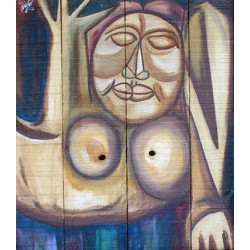Ismael Mundaray
Painter, engraver and artist. At the beginning of the eighties he investigates the influence of cocoa in the Venezuelan colony, studies graphic arts at the Cristóbal Rojas School and begins his exhibition activity at the Ángel Boscán Gallery. By 1983 he worked engraving with Luis Chacón and Oswaldo Verenzuela; At the beginning of this experience, he uses the techniques and the traditional role of engraving, to later use handmade papers to which he adds bamboo, cotton or guava vegetable fibers, in order to achieve a more primal expression. He participates in the VIII National Art Hall of Maracay and then exhibits in the Fantoches Gallery (Caracas), 48 works that include drawings, engravings and assemblies built with wood, cloth remains and scrap materials. In 1986 he received the first prize of experimental art from the I Biennial of Visual Arts of the East (Cumaná) with the work Harmonic Expressions, and is invited to the II Biennial of Havana where he participates with a craft paper installation. In 1987 he exhibited in Martinique, gave workshops on papermaking and presented in the Exhibition Hall of the Venezuelan Embassy in Bogotá, a selection of 40 works in which he inquired about the symbology of black and indigenous peoples. At that time his work focuses on the color, the gesture, the relationship of the figure with the final bill of the work, the fabric support, the industrial paint, the synthetic enamel, the graphite and the oil to touch the pictorial surface That same year he exhibited in the Mayz Lyon Gallery (Caracas) an atmosphere with natural elements accompanied by 35 paintings made with industrial enamel and oil on canvas in various formats. In 1988 he participated in the National Salon of Plastic Arts (Museum of Fine Arts) with the piece Ash Wednesday, an intervention with handmade paper and natural materials in which he reflected on the symbolism and meaning of the religious festival; he exhibits "Les animaux" at the Mayz Lyon Gallery (Caracas) where he explores the symbology of animals used in santeria, and receives the unique engraving prize from the National Salon of Plastic Arts (graphic arts section, MACCSI) with Lent during Holy Week I and II, two engravings made on craft paper. Mundaray's painting has gone through different times. At first the artist starts from the traditional support by using a canvas that hung as a banner; its colors were strong, with a predominance of red and green, with a symbology associated with the ritual and the native, in which tropical and petroglyph animals predominated. Then the human figure enters the scene. The pictorial material, the brushstroke and the color planes contrast with intensity in the mid-eighties; later it reduces the light and enters black as a color and then as a neutral tone that degrades into gray. The objects appear as a white or gold silhouette in the middle of a dark space. When he lived in Paris in 1990, he eliminated the stridency of color in his paintings, synthesized the discourse, the object, the line and the serial appears in his plastic discourse. In 1991 he exhibited "Signs in rotation" (Sala Mendoza), geometric shapes that make up an immense installation in which the artist represents themes such as civilization, childhood, the Berlin Wall, war and its armaments. As of 1992, Mundaray takes up his interest in Venezuelan indigenous cultures and exhibits the exhibition "Shabonos" (Astrid Paredes Gallery, Caracas) in which he will address the theme of the constructions that our original settlers, particularly in southern Venezuela, use as households. In 1993 he continued his pictorial inquiries about indigenous cultures and exhibited "Maloca-Yopo" (Thorigny Gallery, Paris). The artist has maintained in his work a constant interest in these ancestral cultures. With its own language it refers us to the lands of the Amazon, the Orinoco Delta and the Edo. Bolivar. In 1997 he exhibited "Orinoco Project" in the Cultural Hall of Corpoven (Puerto La Cruz), in the Uno Gallery (Caracas) and in the Jacobo Borges Museum. In 2000, the Félix Gallery (Caracas) inaugurates "Travesía", shows that it is part of its artistic macroproject "Del Orinoco al Sena", where it is proposed to transfer its indigenous experiences and its connection with the Orinoco river to the urban area. He received the following awards and recognitions: 1986 First prize of experimental art, First Biennial of Visual Arts of the East, Cumaná; 1988 Single Prize for Engraving, National Salon of Plastic Arts, MACCSI; 1989 Prize of Engraving Bernardo Rubinstein, XLVII Arturo Michelena Hall; 1990 Conac Award, XLVIII Arturo Michelena Hall / Painting Prize, General Council Tribute Liberation of Mandela, Fort-de-France, Martinique / Grand Prix, I Biennial of Visual Arts of Mérida / Painting Prize, Carlos and Alegría Beracasa Foundation, Embassy from Venezuela, Paris; 1991 Emilio Boggio Drawing Award, XLIX Arturo Michelena Room; 1992 Prize for experimental art, II Biennial of Visual Arts of Mérida / Second prize for painting, XVII Salon Aragua, Museum of Art of Maracay / Gold Medal, I Biennial of Painting of the Caribbean, Santo Domingo; 1994 Honorable Mention, IV International Painting Biennial, Cuenca, Ecuador; 1995 Honorable Mention, III Drawing Biennial, Colombo-Venezuelan Salon, Merida / Painting Prize, Embassy of Venezuela, Paris; 1996 Painting Prize, XXVIII International Painting Festival, Cagnes-sur-Mer, France; 1997 Puertos de Anzoátegui Award, IV National Biennial of Plastic Arts of Puerto La Cruz, Municipal Gallery Foundation of Modern Art, Puerto La Cruz.
.
.
.
.
.
.
.
.


